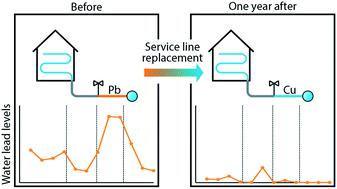当前位置:
X-MOL 学术
›
Environ. Sci.: Water Res. Technol.
›
论文详情
Our official English website, www.x-mol.net, welcomes your feedback! (Note: you will need to create a separate account there.)
Impact of service line replacement on lead, cadmium, and other drinking water quality parameters in Flint, Michigan
Environmental Science: Water Research & Technology ( IF 5 ) Pub Date : 2021-3-12 , DOI: 10.1039/d0ew00975j Nicole C. Rockey 1, 2, 3, 4 , Yun Shen 1, 2, 3, 4 , Sarah-Jane Haig 1, 2, 3, 4 , Madeleine Wax 1, 2, 3, 4 , James Yonts 1, 2, 3, 4 , Krista R. Wigginton 1, 2, 3, 4 , Lutgarde Raskin 1, 2, 3, 4 , Terese M. Olson 1, 2, 3, 4
Environmental Science: Water Research & Technology ( IF 5 ) Pub Date : 2021-3-12 , DOI: 10.1039/d0ew00975j Nicole C. Rockey 1, 2, 3, 4 , Yun Shen 1, 2, 3, 4 , Sarah-Jane Haig 1, 2, 3, 4 , Madeleine Wax 1, 2, 3, 4 , James Yonts 1, 2, 3, 4 , Krista R. Wigginton 1, 2, 3, 4 , Lutgarde Raskin 1, 2, 3, 4 , Terese M. Olson 1, 2, 3, 4
Affiliation

|
In April 2014, Flint, MI switched its drinking water source from water treated in Detroit to Flint River water without applying corrosion control. This caused lead and other metals to leach into drinking water. To mitigate lead exposure, Flint began to replace lead service lines and galvanized iron service lines in March 2016. In this study, the short- and long-term impact of service line replacement on Flint drinking water quality was investigated. In particular, lead and other metal concentrations, chlorine residual, and levels of select microbial populations were examined before and two and five weeks after SL replacement in water collected from 17 Flint homes. Overall, lead levels in premise plumbing water did not change significantly within five weeks of replacement, however, significant reductions were observed two weeks after service line replacement in flushed samples representative of distribution system water (pre-replacement median = 0.98 μg L−1; two-week post-replacement median = 0.11 μg L−1). Multiple sequential samplings from one Flint residence before and 11 months after service line replacement revealed large reductions in lead levels in all samples, indicating long-term benefits of service line replacement. Cadmium was also detected at levels at or above the federal maximum contaminant level. Microbial analyses established that 100%, 21%, and 52% of samples had quantifiable concentrations of total bacteria, Legionella spp., and Mycobacterium spp. as measured by quantitative PCR, while Legionella pneumophila was not detected in any samples. Our results provide evidence that both lead service line and galvanized service line replacement benefit consumers in the long term by reducing drinking water lead concentrations, while short-term advantages of service line replacement in sites with prior lead seeding of in-home plumbing are less apparent.
中文翻译:

密歇根州弗林特的服务管线更换对铅,镉和其他饮用水水质参数的影响
2014年4月,密歇根州弗林特市在不采用腐蚀控制的情况下,将其饮用水源从在底特律处理过的水改成了弗林特河水。这导致铅和其他金属渗入饮用水。为了减少铅的暴露,Flint从2016年3月开始更换铅服务线和镀锌铁服务线。在本研究中,研究了服务线更换对Flint饮用水水质的短期和长期影响。特别是,在从17户弗林特家庭收集的水中进行SL替换之前,替换之后两周和五周之后,检查了铅和其他金属的浓度,氯残留量以及特定微生物种群的水平。总体而言,在更换后的五周内,室内自来水中的铅含量没有明显变化,-1 ; 更换后两周的中位数= 0.11μgL -1)。在更换服务线之前和之后的11个月内从一个Flint住所进行了多次连续采样,发现所有样品中的铅含量均大大降低,这表明更换服务线可带来长期利益。镉的含量也达到或超过联邦最高污染物含量。微生物分析表明,样品中100%,21%和52%的总细菌,军团菌属和分枝杆菌属具有可量化的浓度。通过定量PCR进行测量,而肺炎军团菌在任何样品中均未检测到。我们的结果提供了证据,表明铅服务线和镀锌服务线的更换都可以通过降低饮用水中铅的浓度长期使消费者受益,而在事先铺设了室内管道铅的场所更换服务线的短期优势却不那么明显。 。
更新日期:2021-03-12
中文翻译:

密歇根州弗林特的服务管线更换对铅,镉和其他饮用水水质参数的影响
2014年4月,密歇根州弗林特市在不采用腐蚀控制的情况下,将其饮用水源从在底特律处理过的水改成了弗林特河水。这导致铅和其他金属渗入饮用水。为了减少铅的暴露,Flint从2016年3月开始更换铅服务线和镀锌铁服务线。在本研究中,研究了服务线更换对Flint饮用水水质的短期和长期影响。特别是,在从17户弗林特家庭收集的水中进行SL替换之前,替换之后两周和五周之后,检查了铅和其他金属的浓度,氯残留量以及特定微生物种群的水平。总体而言,在更换后的五周内,室内自来水中的铅含量没有明显变化,-1 ; 更换后两周的中位数= 0.11μgL -1)。在更换服务线之前和之后的11个月内从一个Flint住所进行了多次连续采样,发现所有样品中的铅含量均大大降低,这表明更换服务线可带来长期利益。镉的含量也达到或超过联邦最高污染物含量。微生物分析表明,样品中100%,21%和52%的总细菌,军团菌属和分枝杆菌属具有可量化的浓度。通过定量PCR进行测量,而肺炎军团菌在任何样品中均未检测到。我们的结果提供了证据,表明铅服务线和镀锌服务线的更换都可以通过降低饮用水中铅的浓度长期使消费者受益,而在事先铺设了室内管道铅的场所更换服务线的短期优势却不那么明显。 。


























 京公网安备 11010802027423号
京公网安备 11010802027423号